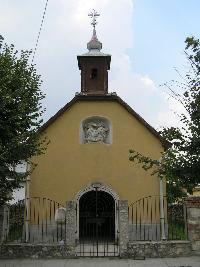Chapel of Saint Sebastian, Saint Rokus and Saint Rosalia
Translated by Dóra Lukács
“The chapel was built towards Buda Street, next to the Roman road and the Turkish mosque in 1734, at the time of the great plague, in honour of Saint Rosalia and Fabian Sebastian. It is maintained by the people and has one bell, which bell is dedicated to Saint Rochus and the Saint Cross.” (Gy. Kereskényi. 1886. p. 10.)
We can step into the chapel through the entrance with a carved keystone. The altar was originally decorated with wonderful, 18th-century wooden statues of Saint Sebastian, Saint Rokus and the child Saint Rosalia. The rectangular chapel ends in an arched apse. There is a window on each sidewall. The wooden structure of the bell tower is added with a graceful spire. The main front is decorated with a statue of the Trinity placed in an arched booth in the wall. A column of the Trinity stood in front of the chapel. It is probably that the statue now standing on the front was originally on the Trinity Column.
Left to the entrance is a chalice of holy water built into the wall. The roof of the bell tower and the chapel was covered with shingle in the 18th and 19th centuries, but it was changed to tin, then later to tiles.
A fence, the corners of which were strengthened with carved stones, surrounded the chapel. The gate of the fence was emphasized with the help of two rectangular columns with stone statues on the pyramid-shaped cover stones. The statues probably were parts of the Trinity Column; they were placed on the fence only later. They are possibly the statues of Saint Rokus, Saint Rosalia and Saint Sebastian. The statues have obviously been through a lot as they are severely damaged and fragmented. Today they can be viewed in the courtyard of the parsonage.
In the photo taken in 1955, not only the statues but also the plaster decoration of the front are visible. It is unfortunate that this was not taken into consideration when the chapel was renovated in 1984. The shape of the fence was changed significantly as well.
If viewed carefully, the photo shows the simple, charming representation of the pieta placed on the corner of the fence. The statue is now in the courtyard of the parsonage. Until new documents emerge it is only a hypothesis that this Pieta stood in the booth of the front at the time when the Trinity Statue still decorated the Column in the square in front of the chapel.
During the renovations of 1984, a carved stone depicting the skull and crossbones was built into the fence, which was probably made when the chapel was first built, in remembrance of the horrible devastation of the epidemic.
It is interesting that Ferenc Wajthay’s topography from 1846 ignores the statue in the booth, and he didn’t think it was an important detail to draw.
